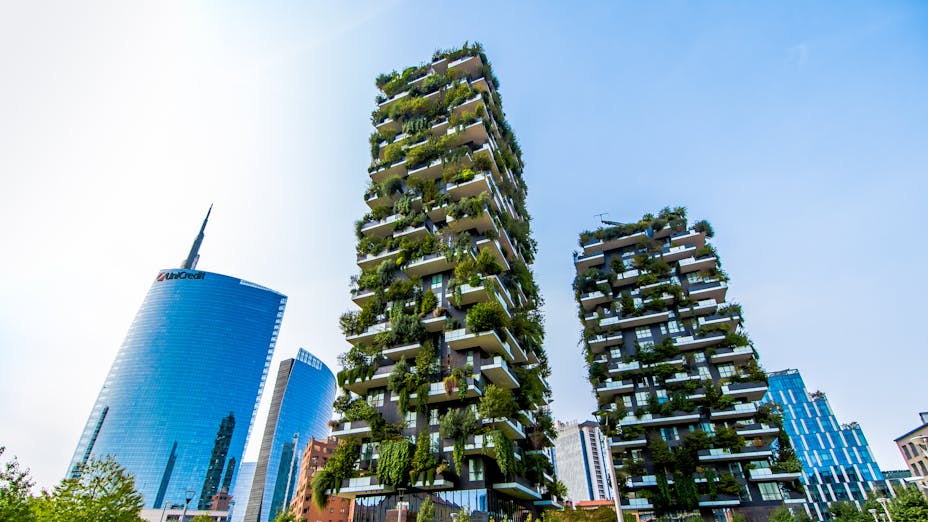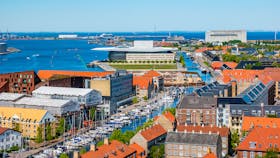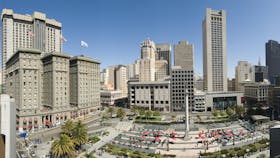In 2014, Milan inaugurated the Bosco Verticale (or Vertical Forest) residential towers. While construction began in 2009, the completion of the buildings changed the skyline of Milan’s Porta Nuova district. Conceptualised as part of the city’s rehabilitation initiatives, at the time of its completion the project was one of Europe’s biggest redevelopments. It is a showpiece for when local governments put energy-efficiency and green development on their agenda.
Orti Urbani (or urban architecture) is appealing to Milan’s citizens. Residents are discovering the natural dimensions in the city, a direct consequence of the “green roofs” financing programs. The city is also experimenting with advanced technologies to enable vertical farming projects.
Managing a building’s entire lifecycle of carbon emissions is a strategy that every city needs to consider. Milan’s dedication to reducing greenhouse gas emissions started long before they commissioned the redevelopment of Bosco Verticale. In 2008, the city hosted the OECD conference for Competitive Cities and Climate Change. According to the mayor of Milan at the time, cities needed a new model to protect populations, reduce the effects of climate change, and provide healthier living environments. With the city’s aging building stocks and increasing energy costs, energy-efficient renovation became a priority for city officials. Investing in green-energy renovations also helps reduce Italy’s energy bills, making it a key driver for economic growth and resilience.
Key challenges facing Milan’s renovation efforts
Although the city remains committed to achieving its green goals, it will not be easy. Challenges in the city’s historical infrastructure will take a concerted effort from residents, city officials, and the private sector. With 49 percent of all occupied dwellings being multi-owned or condominiums, renovating buildings needs consensus from the different private owners. This presents a major obstacle to any initiative as the decision-making process easily can take more than a year.
Milanese residents are also quite proud of their buildings and historical designs. Any type of project has to take the history of the specific structure into account. As an urban centre steeped in culture and European history, renovating buildings in the city (or the region of Milano) needs to preserve its legacy while improving the structure’s energy-efficiency. Special focus should also be on making the city’s structure more resilient against natural disasters like earthquakes. The Italian government has a tax incentive that allows renovators to write off 65 percent of renovation costs as tax breaks.
Taking urban climate action now can help improve a city’s resilience in the future. People spend 90 percent of their time in homes or other buildings. To keep populations safe and healthy now and for years to come requires increased effort to improve indoor air quality, building thermal and acoustic insulation, and seismic performance of their structures.
Regardless of these challenges, placing renovation on the agenda can also benefit the local economy. Italy was one of the regions hardest hit by the COVID-19 pandemic. Milan also faces significant air pollution problems. The city’s transport systems compounded the issues surrounding the pandemic but buildings also contribute to the problems.
The impact on the economy and health of the population will require an innovative strategy to aid their recovery. Using renovation policies to restart economic activity is a smart and novel way to jumpstart the city’s commercial and building sectors. It will also address the enormous problem of reducing the use of pollutant-extensive heating and cooling systems.
Transforming Milan with the 2030 city plan
Milan’s officials remain committed to improving the quality of life for their citizens. The City Master Plan of Milan sets out strategies for urban development, sustainable mobility, a sharing economy, energy-efficiency, and developing an integrated smart city.
In Milan’s view, the philosophy of a smart-city does not start and end with technology. It relates to an integrated living environment that supports all of their population’s activities. According to the city’s bold agenda, their city plan for 2030 will provide:
- Adoption of a range of energy-efficient solutions to improve resilience, wellbeing, and the health of communities
- Smart inclusion of communities and citizens in the city’s plans
- The smart reimagining and re-orientation of transport systems
- Standardised payment technologies and methods
Setting up a demonstration area for Milan’s Sharing Cities project
Started in 2016, the Sharing Cities is a partnership between six cities and 34 partners composed of industry representatives, academia, and non-governmental organizations. Milan is one of the ‘Lighthouse’ cities, which attempts to find a better, common approach to making smart cities a reality.
To develop the processes, tools and technologies required for achieving their 2030 goals, the city designated the districts of Porta Romana and Vettabbia as a demonstration area. A brownfield project of a former railway yard will receive complete redevelopment to stitch together two areas historically separated geographically, socially, and economically. After the renewal, the areas will have a functional mix of private and social housing units, the multimodal integration of transport systems, and a 187,226 square meter park.
The focus of the district’s smart city developments include:
- Retrofitting buildings for the benefit of the district’s inhabitants
- Developing a sustainable energy management service
- Engaging with citizens to find innovative strategies that encourage positive behavioural changes
- Creating an urban sharing platform and upgrading lighting to smart lampposts
- Investing in e-mobility solutions like e-cars, e-bikes, e-logistics, charging points, and smart parking lots
Examples of how renovation is helping Milan improve the city’s resilience
One project that perfectly illustrates the goals of the Sharing Cities program is the renovation of the Viale Murillo apartment building. Situated in one of the historical neighbourhoods of the city, the building dates back to 1905, and obviously, its architect did not design it with energy-efficiency in mind. Renovating the structure posed many of the same challenges that cities throughout Europe are facing due to the historical prominence of the building, the unique façade, and the building’s private ownership.
Retrofitting the building led to an 80 percent reduction of energy demand for a floor area of 930 square meters, while retaining the original mouldings and profiles of the recognisable structure. To achieve this, they used a custom-designed External Thermal Insulation Composite System (ETICS) as cladding for the load-bearing masonry.
The project was renovated with a limited cost to the owners of the building due to the attractive tax incentive program available in Milan. The Milan municipality also decided to support the project financially with 15 percent and to use the project as a showcase for the Sharing City project.
Calculating the benefits of retrofitting structures for energy-efficiency
Milan has also engaged as a pilot city with C40 and used a tool developed by C40 and ROCKWOOL to calculate the wider benefits available from retrofitting existing buildings towards more energy-efficient buildings.
For Milan, the analysis will be used as part of a bid for a EUR 24 million grant (USD 33.3 million) that would enable further building retrofits and replace 3,500 gasoline-powered heating systems. These heating systems account for 30 percent of particulate-matter air polluting in Milan, so such renovation action would significantly reduce the health impacts associated with poor air. A large-scale renovation project of these buildings and systems could help reduce the adverse health effects of air pollution in the city significantly.
One cannot overstate the benefits of using deep renovation to improve a city’s health and its citizens’ wellbeing. Reducing energy use in buildings remains a key component that can help motivate homeowners, residents, decision-makers, and politicians. Ensuring that occupants buy into any large-scale renovation project starts with quantifying the benefits such as cost-savings, improved health, and overall comfort for the inhabitants.
We continue to support programs that help the world’s cities become more resilient, healthy and sustainable.








